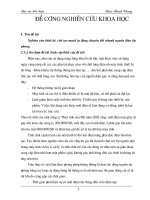Tài liệu Chapter 3: Vectors docx
Bạn đang xem bản rút gọn của tài liệu. Xem và tải ngay bản đầy đủ của tài liệu tại đây (235.04 KB, 11 trang )
Chapter 3 Vectors
In Physics we have parameters that can be completely described by a
number and are known as “scalars” .Temperature, and mass are such
parameters
Other physical parameters require additional information about direction and
are known as “vectors” . Examples of vectors are displacement, velocity
and acceleration.
In this chapter we learn the basic mathematical language to describe
vectors. In particular we will learn the following:
Geometric vector addition and subtraction
Resolving a vector into its components
The notion of a unit vector
Add and subtract vectors by components
Multiplication of a vector by a scalar
The scalar (dot) product of two vectors
The vector (cross) product of two vectors
(3-1)
An example of a vector is the displacement vector which
describes the change in position of an object as it
moves from point A to point B. This is represented by an
arrow that points from point A to point B. The length of
the arrow is proportional to the displacement magnitude.
The direction of the arrow indicated the displacement
direction.
The three arrows from A to B, from A' to B', and from A''
to B'', have the same magnitude and direction. A vector
can be shifted without changing its value if its length and
direction are not changed.
In books vectors are written in two ways:
Method 1: (using an arrow above)
Method 2: a (using bold face print)
The magnitude of the vector is indicated by italic print: a
a
r
(3-2)
Geometric vector Addition
Sketch vector using an appropriate scale
Sketch vector using the same scale
Place the tail of at the tip of
The vector starts from the tail of
and terminates at the tip of
a
b
b a
s a
s a b= +
r
r
r
r
r r
r
r
r r
commutative
Negative of a given
Vector addition is
has the same magnitude
vecto
as
but opposite direction
r b b
b
a b b a
b b
−
+ = +
−
r r
r r
r r
r r
(3-3)
Geometric vector Subtraction
( )
( )
We write:
From vector
Then we add to vector
We thus reduce vector subtraction to
vector addition which we know how to do
we find
d a b a b
b b
b
b
a
d a=
= − = + −
−
−
−
r r
r
r r r
r r
r r
r
r
Note: We can add and subtract vectors using the method of components.
For many applications this is a more convenient method
(3-4)
A
B
C
A component of a vector along an axis is the projection
of the vector on this axis. For example is the
projection of along the x-axis. The component
is defined by drawing straight lines fr
x
x
a
a a
r
om the tail
and tip of the vector which are perpendicular to
the x-axis.
From triangle ABC the x- and y-components
of vector are given by the
cos ,
equations:
If we know
in
s
x y
a a a
a
a
a
a
θ θ
= =
r
r
2 2
and we can determine and .
From triangle ABC we h
, tan
ave:
y
x
x
y
x
y
a
a a
a
a a
a
θ
θ
= + =
(3-5)









